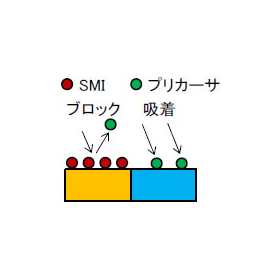[TEM-EELS] Electron Energy Loss Spectroscopy
By measuring the energy lost due to interactions with atoms as electrons pass through thin film samples, the constituent elements and electronic structure of the material can be analyzed.
EELS analysis is a method that measures the energy lost by electrons as they pass through thin samples due to interactions with atoms. It can analyze the constituent elements and electronic structure of materials. Compared to the elemental analysis device (EDX) attached to a TEM, it has the following features: - Better sensitivity for light elements compared to EDX - Higher energy resolution compared to EDX - Higher spatial resolution compared to EDX, making it difficult to detect surrounding information - Chemical state analysis is possible for certain elements
basic information
EELS is a spectroscopic method that analyzes the composition and bonding states of elements in a sample by measuring the energy lost by an incident electron beam as it excites electrons within the sample. EELS can be broadly divided into three regions: 1. Electrons that have passed through the sample without interacting (zero-loss electrons) and those that have elastically scattered. 2. The low-energy side of the valence electron excitation region, below 30 eV, which includes plasmons and interband transitions. 3. The inner-shell electron excitation region, which varies depending on the transitions from inner shell levels and is used for compositional analysis.
Price information
-
Delivery Time
Applications/Examples of results
■Composition analysis and surface analysis of microdomains (0.2nm to 1μm) ・Qualitative analysis - evaluation of light elements and transition elements ・Evaluation of the chemical state of elements - crystalline/amorphous carbon - evaluation of phase transitions and bonding states of compounds ・Evaluation of sample thickness
Detailed information
-

Please consult with us first. ★ We will start by proposing an analysis plan ★ Meetings at your company are, of course, possible. We will carefully explain the analysis results and leave no questions unanswered. Please contact us at 03-3749-2525 or info@mst.or.jp!
-

We will conduct a visiting seminar. ★ We offer free seminars tailored to the needs of our customers with visiting engineers ★ Depending on your requests, we will introduce analysis techniques and explain analysis data. ◆ Examples of seminar content - Broad explanation of MST analysis methods - In-depth explanation of specific analysis methods from the principles - Explanation of analysis data requested by the customer Please contact us at 03-3749-2525 or info@mst.or.jp!
Recommended products
Distributors
MST is a foundation that provides contract analysis services. We possess various analytical instruments such as TEM, SIMS, and XRD to meet your analysis needs. Our knowledgeable sales representatives will propose appropriate analysis plans. We are also available for consultations at your company, of course. We have obtained ISO 9001 and ISO 27001 certifications. Please feel free to consult us for product development, identifying causes of defects, and patent investigations! MST will guide you to solutions for your "troubles"!



















































